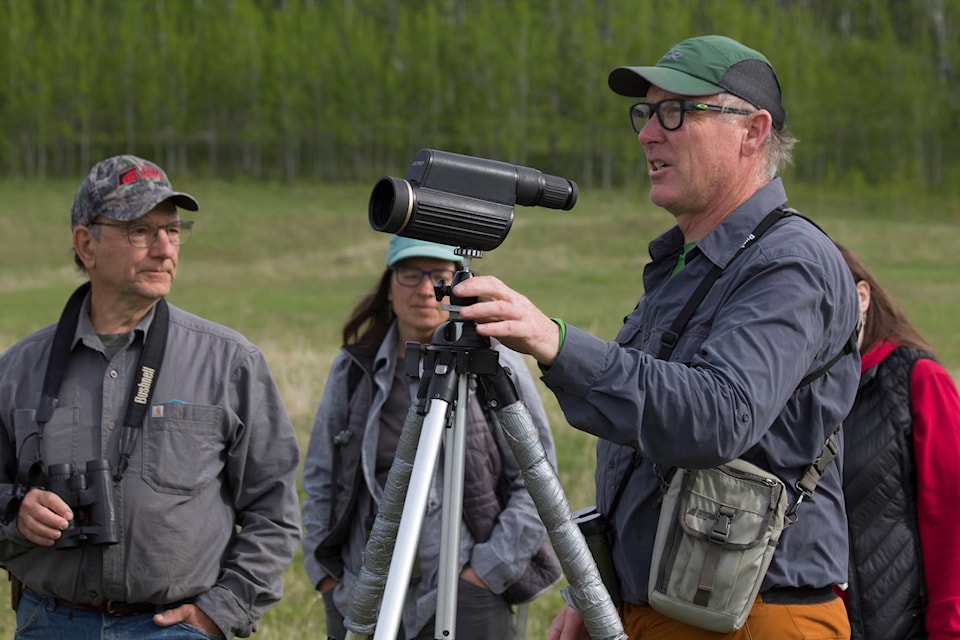It’s early morning near Horse Lake and the birds have been up for hours, singing.
Ken MacKenzie and Kristi Iverson lead a small group of birders to a nearby pond. MacKenzie stops suddenly, and the group falls silent, listening as a clear shweep, schweep comes from the trees.
“Dusty flycatcher,” MacKenzie announces, ticking off the bird in the small notebook he carries when doing tours for the Horse Lake Community Farm Co-Op. “Flycatchers are notoriously difficult to identify, they all look the same so they’re identified by song.”
MacKenzie has been an avid birder for decades, having studied biology, ornithology and forestry in university. Each spring since 2015, he has taken groups of people on a bird and botany walk around the Co-op farmlands, in search of spotting rare and common birds and plants in the region. “You can bird at any time of the year, of course, but the best birding is usually in the spring,” he said.
There were no particularly rare birds seen or heard Sunday, but the air was alive with song. MacKenzie noted each bird has its own melody, which can change from region to region and helps to distinguish where they come from. Chipping Sparrows, for instance, have a song that someone described as if they’re chipping their teeth, while the Ruby-Crowned Kinglet sounds like it’s singing “chubby, chubby cheeks, chubby, chubby cheeks.”
“I think if you’re musically inclined birding is a lot easier, you can pick up on the different notes,” MacKenzie told the Free Press during the walk. “It’s really interesting. There are thousands of species in Canada. It’s diverse enough that they occupy all kinds of different habitats but they’re known - they’re easy to identify, easy to find in a field.
READ MORE: Annual Christmas bird count returning to 100 Mile House
“From a scientific point of view, birds are very easy to work on, measuring changes in a bird habitat relatively easy, and they’re beautiful and they’re dinosaurs. They’re living dinosaurs, which is crazy and cool. They’re beautiful to look at and to listen to.”
Some 32 species were recorded during the morning walk. Among them were the Golden Crowned Kinglet, Yellow-Rumped Warbler, Savannah sparrow, tree swallow, flicker, Orange-Crowned Warbler, hummingbird and the Junco, which has a similar song to the Chipping Sparrow but is more melodic. Snipes, song sparrows, and woodpeckers were also heard or seen, along with a raven, osprey, crow and even a Bald Eagle.
MacKenzie caught some of the smaller songbirds in his scope, but others were too quick, flitting from tree to tree. “Some of these birds are bright red and bright orange but when they don’t move it’s amazing how hard they are to see,” he said.
Warbling Vireos, “probably the most abundant bird in our aspen forests,” added their melodies to the mix. “It sounds like it’s singing through its nose a bit,” MacKenzie said, peering through his binoculars toward the trees. “Vireos have great nests, they suspend between two branches with spiderwebs and cover with green or brown lichen.”
The group was limited to 10 people due to COVID-19 restrictions although up to 30 people had attended in the past. The list of species was also “a bit lower than we typically get, but you can’t really draw any conclusions from a single day,” MacKenzie said. “It was pretty warm, and usually birds sing less frequently when it’s warm.”
A couple of Sandhill cranes, once endangered but no longer at risk, were also spotted but there was no sign of the blue-listed barn swallow. MacKenzie noted that all birds are facing increasing threats.
Still, on the farm, it was a good day for the birds. “A lot of people get mad at the birds in four in the morning when they wake them up but I love them.”
kelly.sinoski@100milefreepress.net
Like us on Facebook and follow us on Twitter
